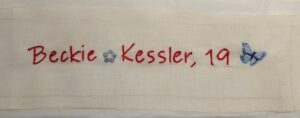By Althea Church

On March 25, 1911, a fire broke out at the Triangle Shirtwaist Factory in New York City. Tatter Blue Textile Library is honoring the 146 garment workers lost in the disaster, caused when an 8th-floor cutting room door was locked to prevent unscheduled breaks or inviting union organizers in. There was no escape as fire and smoke filled the upper floors.
Tatter asked participants in the memorial event to “adopt” a name and age to embroider on a 12×3” piece of white fabric in the union (ILGWU) colors of red and blue. The 146 names will be joined in a large banner.
While quietly sitting at my table, sunlight pouring in to help me see the pattern and embroidery stitches, I thought often of Beckie Kessler and her courage and determination as a fifteen-year-old immigrating across a wide ocean, likely in lower-deck steerage, to a new and unknown future. Was it Jewish persecution that led her to flee Russia in the hopes of a free life in the west and the chance to work hard and earn a living to help her parents or save for marriage and a family of her own?
I could picture the bright face of this hopeful young woman arriving at Ellis Island, being met by perhaps cousins who had already made the journey and had sent letters back home encouraging others to join them.
These are my imaginings, as little is known for certain about Beckie Kessler except her parents’ names on the death certificate and her burial site, which you can view on Find a Grave.
In an example of “yellow journalism,” Miriam Finn Scott, a writer for The Outlook, a social and political weekly of the time, includes Beckie Kessler’s name in a long piece called “Factory Girl’s Danger” just one month after the fire. The article mentions that “a black marriage canopy and bowed young man with streaming eyes following the coffin,” likely a fictional account, but one can believe that Beckie did have dreams and hopes of a happy future ahead with a husband and children. All the hopes and dreams of 146 women, girls, and men were dashed that horrible day.
Justice is a long road, and progress is slow. The Triangle Shirtwaist Fire led to safety standards legislation and the growth of the International Ladies Garment Workers Union (now part of Unite Here union, with a membership much smaller than at its peak of 450,000 in 1969). It took another fifty years for OSHA to become a federal agency. While much of garment manufacturing moved away from the United States to China and Southeast Asia, the protection of unions did not go with it. In 2012 a fire at a Bangladeshi garment factory killed 112 people and injured many more. On Beckie Kessler’s banner, I added a forget-me-not and a butterfly. Together they mean, to me, that we should never forget the tragedies that happen when powerful, greedy factory owners, politicians, and leaders care more, much more, about their pocketbooks than about the people who make their fortunes possible.
Return to List of Contributions
